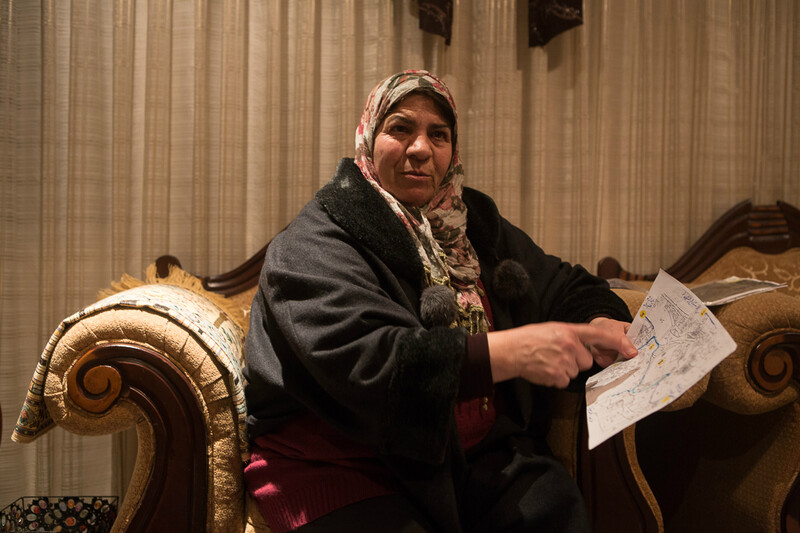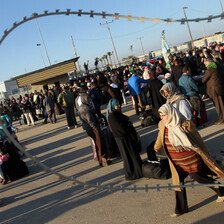The Electronic Intifada Hebron 23 January 2014

Feryal Abu Haikal is determined to stay on her land, despite frequent violent attacks by Israeli settlers and soldiers.
The Electronic IntifadaIsraeli settlers recently began an alleged archaeological excavation on two plots of land surrounding a Palestinian family’s homes in the Tel Rumeida neighborhood of Hebron.
Feryal Abu Haikal, 68, is a retired school principal and mother of 11. She told The Electronic Intifada that settlers and soldiers arrived on 5 January and razed the orchards her family had farmed for decades. “They ripped out 50 of our almond trees. Some of [the trees] were over 60 years old.”
The Abu Haikal family owns the land, on which its four homes are located. Yet the family has also been renting and farming the neighboring two plots of land — six dunams, or almost an acre and a half — for more than 65 years (a dunam is equal to 1,000 square meters).
Originally belonging to the Islamic Waqf society, a large area of land in Tel Rumeida was rented to a Jewish organization in Hebron during the time of the British Mandate of Palestine (1920-1948). From that broader area, the organization first rented the two plots of land to the Abu Haikal family.
Following the 1948 Nakba — the forced displacement of Palestinians ahead of Israel’s establishment — the West Bank came under Jordanian control. The two plots of land were placed under the care of the Jordanian government, which continued to rent them to the Abu Haikal family.
Closed military zone
Following Israel’s 1967 occupation of the West Bank, the family continued to rent these plots from an Israeli Jewish religious foundation as protected tenants. In 2002, the Israeli army invoking “security reasons,” built a fence and declared the area a closed military zone.
Israeli settlers claim the two plots of land are home to the burial site of Yishai and Ruth the Moabite, figures present in Islamic, Christian and Jewish traditions. Similar to plans in several other areas in occupied East Jerusalem and the broader West Bank, they plan to build an archaeological park.
The Israeli government is financing the project to the tune of an estimated seven million shekels (around two million dollars), according to the Israeli daily Haaretz (“Israeli government funding dig in Palestinian Hebron, near Jewish enclave,” 9 January 2014).
Abu Haikal fears that the settlers have larger plans than what they have publicly declared. “Seven million shekels … it’s not possible they will stop [the excavation project] after just two pieces of land,” she said.
“What kind of project needs seven million shekels from the Israeli cultural ministry? They’re going to excavate throughout all of Tel Rumeida.”
Because the military has erected fences closing off the area, the Abu Haikal family’s homes are only accessible by one narrow entrance. On two sides of the homes are closed military zones they are forbidden from entering, and on the other side is an Israeli military base and settlement.
In Hebron, there is a permanent presence of more than 3,000 soldiers to protect a settler population of only around 600 persons.
Tel Rumeida is situated in the H2 area of the city, which is under complete Israeli military control and puts Palestinian residents in constant contact with both settlers and soldiers. “The problem is not just the number of settlers here. It’s also how they think,” said Abu Haikal.
Violent reputation
Israeli settlers in Tel Rumeida have a reputation as some of the most violent in the West Bank. Among them is Baruch Marzel, a US-born settler and former spokesperson for Kach, a right-wing Zionist group that has been deemed a terrorist organization by the United States, Canada, the European Union and Israel.
Over the years, Abu Haikal has accumulated several videos and photographs of settlers and soldiers attacking local Palestinian residents, including her children. The scenes include Israeli tanks rolling across her yard and soldiers violently arresting Palestinians.
Around 20 settlers, while working on the excavation, recently “threw rocks and smashed out eight house windows on the first and second floor of our house,” said Abu Haikal. “They also attacked some of our neighbors.”
Although Israeli settlers assault Tel Rumeida’s residents on a near-daily basis, the Israeli military has only bothered to arrest Palestinians.
As the settlers uprooted their almond trees on 5 January, Abu Haikal’s nephew Sami was arrested after entering the excavation area. Soldiers told the family he had broken the law by going into a closed military zone.
“The settlers attack Palestinian homes, throw stones, and often physically beat up Palestinians, including women and kids,” said Issa Amro, coordinator of Youth Against Settlements, a Hebron-based group that raises awareness about Israel’s activities in the city.
Goal of displacement
He told The Electronic Intifada that the areas of the city under the most pressure right now are Tel Rumeida, Shuhada Street and the Ibrahimi Mosque.
“In these areas, the soldiers are arresting kids, detaining them and giving them a hard time. It’s putting more pressure on us … for the goal of displacing Palestinians here.”
An Israeli soldier allegedly threatened to kill a Palestinian schoolgirl near the Ibrahimi Mosque as she was making her way home, reported Ma’an News Agency last week (“Hebron schoolgirl says Israeli soldier threatened to kill her,” 15 January 2014).
Hamed Salem, the chairperson of Birzeit University’s archaeology department, spoke to The Electronic Intifada about Israel’s use of archaeology to implement expansionist policies.
“This is one of the many illegal excavations taking place,” Salem said, referring to the digs in Hebron.
“Archaeology as propaganda”
Rather than being a legitimate archaeological project, Salem noted, it is about “the settlers’ political agenda. They are using archaeology as propaganda to justify their presence” in Hebron.
Salem added that the archaeological park in Tel Rumeida “comes from the same idea” as other excavations used by Israeli settlers and authorities to displace Palestinians.
In Silwan, a Palestinian neighborhood in occupied East Jerusalem, an Israeli settler organization has established the City of David, a state-funded archaeological park.
In Khirbet Susiya, a village in the South Hebron Hills, Palestinian residents were expelled from their original lands in 1986 after Israel declared the area an archaeological zone. Today, they live only a few hundred meters away, dwelling in caves and shaky wooden structures that are frequently bulldozed by Israel’s military.
For Tel Rumeida, the expansion of settlements will translate into more settlers, soldiers and violence against Palestinians. Yet Abu Haikal promised that her family is there to stay.
“I love Tel Rumeida,” she said “It’s in my blood. I’d rather die than leave.”
Patrick O. Strickland is an independent journalist and frequent contributor to The Electronic Intifada. His writing can be found at www.patrickostrickland.com. Follow him on Twitter @P_Strickland_.





